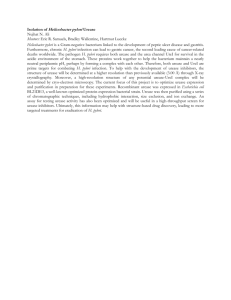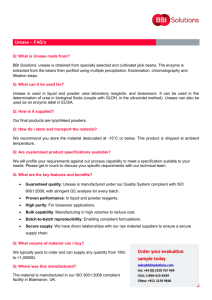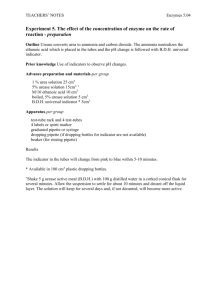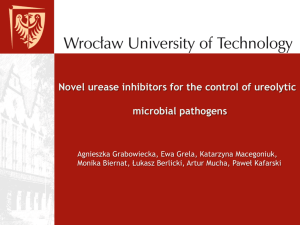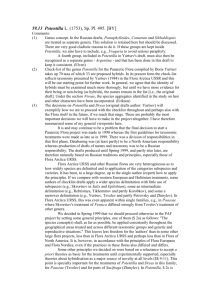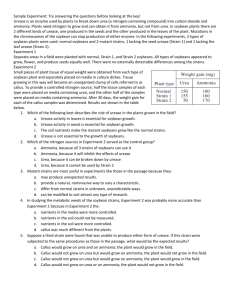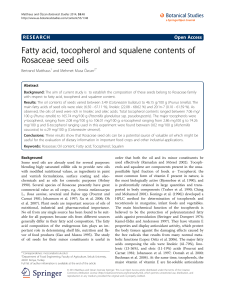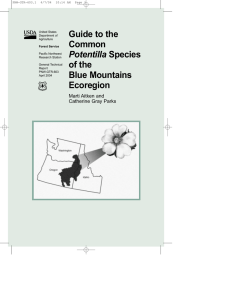supplementary material
advertisement
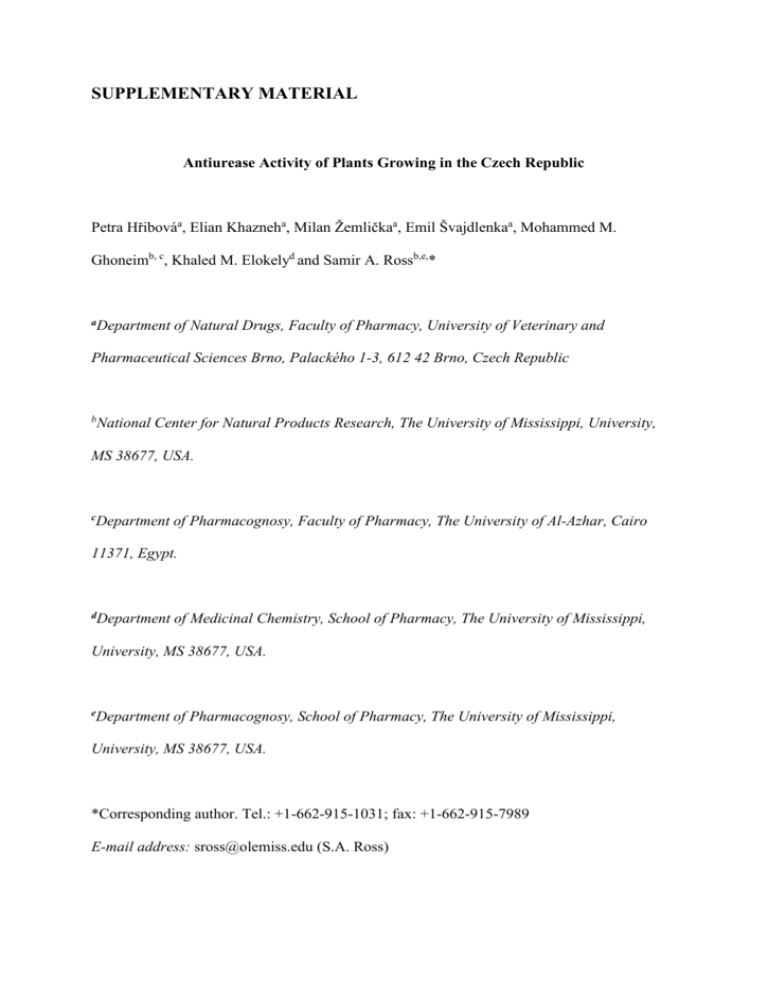
SUPPLEMENTARY MATERIAL Antiurease Activity of Plants Growing in the Czech Republic Petra Hřibováa, Elian Khazneha, Milan Žemličkaa, Emil Švajdlenkaa, Mohammed M. Ghoneimb, c, Khaled M. Elokelyd and Samir A. Rossb,e,* aDepartment of Natural Drugs, Faculty of Pharmacy, University of Veterinary and Pharmaceutical Sciences Brno, Palackého 1-3, 612 42 Brno, Czech Republic b National Center for Natural Products Research, The University of Mississippi, University, MS 38677, USA. cDepartment of Pharmacognosy, Faculty of Pharmacy, The University of Al-Azhar, Cairo 11371, Egypt. dDepartment of Medicinal Chemistry, School of Pharmacy, The University of Mississippi, University, MS 38677, USA. eDepartment of Pharmacognosy, School of Pharmacy, The University of Mississippi, University, MS 38677, USA. *Corresponding author. Tel.: +1-662-915-1031; fax: +1-662-915-7989 E-mail address: sross@olemiss.edu (S.A. Ross) Abstract The antiurease activity of the aqueous extracts of 42 plants growing in the Czech Republic was investigated. A phenol-hypochlorite reaction was used for determination of ammonia produced by urease. The inhibitory activity of the extracts at concentration of 0.2 mg/ml varied from 17.8% to 80.0%. Extracts from six Potentilla species showed inhibitory activity against jack bean urease. They were further investigated for their phenolic constituents and the major compounds were submitted to molecular docking. The results showed that both jack bean urease and Helicobacter pylori urease were inhibited by quercetin-3-O-β-Dgalactopyranoside-6´´-gallate (1), myricetin-3-O-β-D-glucuronide (2), tiliroside (3) and Btype procyanidin (4). The antiurease activity of the investigated Potentilla species is probably due to the presence of complex phenolic constituents such as flavonoid glycosides and catechin dimers. Key words: Docking; Phenolic constituents; Phenol-hypochlorite; Potentilla species; Urease. Table S1: Plant Name* Aesculus carnea (leaves) Allium ursinum (flowers) Allium ursinum (leaves) Catalpa bignonioides (leaves) Chelidonium majus Chrysanthemum balsamita Clematis recta Clinopodium vulgare Echium vulgare Eruca sativa Fagopyrum aesculentum Hyssopus officinalis Inula britanica Lamium album Lyriodendron spp. Magnolia spp. (leaves) Marubium vulgare Meum athamanticum Nigella damascena Nigella integrifolia Nonea pulla Origanum vulgare Potentilla anserina Potentilla arenaria Potentilla argentea Potentilla aurea Potentilla erecta Potentilla fruticosa Prunella grandiflora Salvia sclarea Solidago virgaurea Sophora japonica Verbena officinalis Yucca filamentosa Acetohydroxamic acid Herbarium No. PAC-07 PAC-08 PAC-09 PAC-11 PAC-14 PAC-15 PAC-16 PAC-17 PAC-21 PAC-22 PAC-23 PAC-24 PAC-27 PAC-28 PAC-29 PAC-30 PAC-31 PAC-32 PAC-33 PAC-34 PAC-35 PAC-36 PAC-49 PAC-50 PAC-51 PAC-52 PAC-53 PAC-54 PAC-37 PAC-38 PAC-39 PAC-40 PAC-41 PAC-42 Family Hippocastanaceae Liliaceae Liliaceae Bignoniaceae Papaveraceae Asteraceae Ranunculaceae Lamiaceae Boraginaceae Brassicaceae Polygonaceae Lamiaceae Asteraceae Lamiaceae Magnoliaceae Magnoliaceae Lamiaceae Apiaceae Ranunculaceae Ranunculaceae Boraginaceae Lamiaceae Rosaceae Rosaceae Rosaceae Rosaceae Rosaceae Rosaceae Lamiaceae Lamiaceae Asteraceae Fabaceae Verbenaceae Asparagaceae - Urease Inhibition ± SEM† [%] 71.0 ± 3.1 67.2 ± 3.6 79.2 ± 0.3 67.4 ± 1.5 62.3 ± 1.0 80.0 ± 0.6 62.0 ± 2.2 68.3 ± 3.2 70.8 ± 2.9 70.5 ± 2.4 71.9 ± 1.4 74.3 ± 2.5 62.0 ± 2.3 61.1 ± 1.8 66.3 ± 3.6 60.9 ± 5.9 61.2 ± 4.9 74.0 ± 3.1 64.2 ± 2.4 69.6 ± 2.6 71.9 ± 1.7 69.7 ± 1.5 73.7 ± 1.9 44.4 ± 0.3 76.0 ± 0.9 56.9 ± 4.2 72.8 ± 2.6 72.2 ± 5.0 63.4 ± 1.6 78.0 ± 3.0 75.6 ± 3.1 60.7 ± 1.9 67.4 ± 7.6 79.0 ± 1.1 72.6 ± 3.6 *Unless otherwise noted in parenthesis, the aerial part of the flowering plant was tested. †Standard mean error from the three determinations. Plant extracts that did not show significant antiurease activity: Borago officinalis (PAC-10), Catalpa ovata (leaves) (PAC-12), Centaurea segetum (PAC-13), Dalanum segetum (PAC-18), Dentaria bulbifera (PAC-19), Duchesnea indica (PAC-20), Impatiens balsamita (PAC-25), Indigofera tinctoria (PAC-26). Table S2: tR [min] Maxima UV [nm] [M-H]- m/z HHDP-glucose 0.9 228, 262 sh 481 301, 275 a,b,c,d,e,f bis-HHDP-glucose 1.0 234, 250 sh 783 765, 722.5 a,b,c,d,e,f epigallocatechin gallate 1.3 230, 274 457 441 b,c,d,e,f bis-HHDP-glucose 2.1 234, 250 sh 783 481, 301 a,c,d,f HHDP-galloyl-glucose 2.4 224, 270 sh 633 301 a,b,c,d,e,f HHDP-galloyl-glucose 2.7 224, 270 sh 633 481, 301, 257 d,f proanthocyanidin dimer (Procyanidin B) 3.4 222, 278 577 451, 425, 407, 289 a,b,c,d,f catechin 3.6 226, 278 289 245, 205 f proanthocyanidin dimer (Procyanidin B) 4.6 222, 278 577 451, 425, 407, 289 a,b,f HHDP-galloyl-glucose 4.9 228, 270 sh 633 498, 301 c bis-HHDP-glucose 5.0 230, 250 sh 783 481, 301 a,f quercetin-diglucuronide 5.1 256, 350 653 477, 301 b,e quercetin-dihexoside 5.3 256, 352 625 463, 301 d quercetin-hexoside-glucuronide 256, 354 639 463, 301 b,d luteolin-diglucuronide 5.6 6.3 256, 348 637 461, 285 b,e (iso)rhamnetin-diglucuronide 6.6 254, 352 667 491, 315, 255 b,e rutin 7.2 266, 344 609 463 d myricetin-3-O-β-D-glucuronide quercetin-3-O-β-D-galactopyranoside6''-gallate 9.1 256, 354 493 317, 259 a,b,d 9.6 254, 368 615 463, 301 a,b,c,e,f quercetin-hexoside 9.9 256, 356 463 301 a,b,c,d,f quercetin-glucuronide 10.0 256, 352 477 301, 179 c,f kaempferol-hexoside 11.0 266, 348 447 285 f (iso)rhamnetin-hexoside 11.0 256, 352 477 315, 165 f (iso)rhamnetin-pentoside kaempferol-3-O-coumaroylglucoside (tiliroside) 11.8 256, 352 447 315 f 14.4 268, 314 593 285 a,c,f Compound MS2 Occurence HPLC-DAD-MS2 data for compounds found in water extracts of Potentilla spp. a P. anserina, b P. arenaria, c P. argentea, d P. aurea, e P. erecta, f P. fruticosa; sh = shoulder; HHDP = hexahydroxydiphenyl-glucose. Figure S1: Compounds 1-4 100 0 2 4.575 4 6 8 10 12 0 14 17.081 14.005 12.510 12.739 14.420 10.984 11.287 11.487 11.679 11.818 11.964 12.180 2 10.508 9.643 1 10.780 600 10.308 4.186 0.932 mAU 10.9.092252 9.145 9.275 9.503 7.966 8.080 8.239 8.407 8.58.89518 8.747 7.080 7.294 7.454 7.623 6.861 6.058 6.369 6.520 2.083 4 4.966 5.139 5.393 3.402 3.640 2.435 2.721 1.453 1.624 1.814 1.085 200 1.295 0.777 Figure S2: Chromatogram of Potentilla fruticosa with the major peak of quercetin-3-O-β-D-galactopyranoside-6''-gallate (1) DAD1A, Sig=254,4Ref=400,50(C:\USERS\P...\PETRAH_ANTIUREASE\EXPRESSRHUS2013-07-0718-59-32\056-1601.D) 500 400 300 3 16 min Figure S3. The binding modes of the compounds in the Helicobacter pylori urease binding pocket. The ligand is shown as sticks with grey carbons. The binding pocket is displayed as partial charge colored surface. The compounds fit well inside the binding pocket (compound 1 up to the left, compound 2 up to the right, compound 3 down to the left and compound 4 down to the right). The figure was prepared by PyMol. Figure S4. The 2D interaction profile of compound 1 in the active site of jack bean urease (left) and Helicobacter pylori (right). The interaction is much more stronger in case of Helicobacter pylori and mostly as hydrogen bonding, ion–dipole and hydrophobic interactions.
